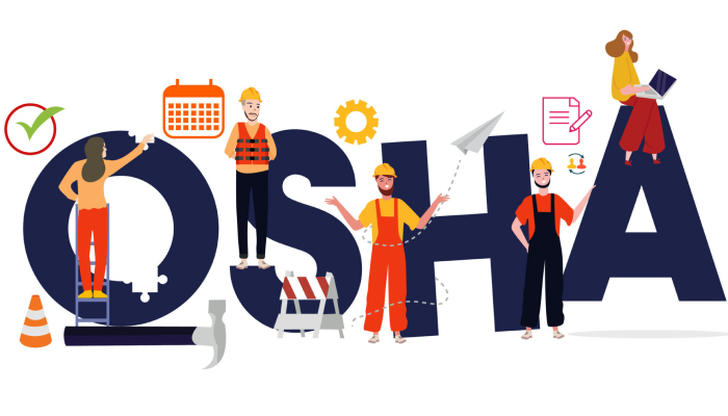Explore OSHA 30 Course: Improve Occupational Safety Skills and Ensure Workplace Health
In many work environments, especially in the construction and manufacturing industries, safety is one of the most important factors. In order to ensure the safety of employees, the Occupational Safety and Health Administration (OSHA) has launched a number of training courses, among which the "OSHA 30" course is considered one of the most authoritative and influential safety training. This course provides detailed safety management knowledge for managers and employees in high-risk industries to help reduce the occurrence of work-related injuries and accidents.
This article will detail the advantages of OSHA 30 courses, how to find these courses, whether there are free OSHA 30 courses, and how to explore career opportunities after learning.

Advantages of OSHA 30 Course
1. Comprehensive safety training
The OSHA 30 course is a 30-hour safety training course that provides detailed explanations of various safety risks that practitioners and managers may face in the work environment. Compared with the OSHA 10-hour course, the OSHA 30 course is more in-depth and covers a wider range of topics. Course content includes but is not limited to workplace safety regulations, accident prevention, emergency response procedures, hazard identification, use of personal protective equipment, etc. Participants can not only learn how to avoid potential safety hazards in daily work, but also master how to take correct emergency measures when an accident occurs.
2. Improve professional competitiveness
Completing the OSHA 30 course and obtaining certification can significantly improve your professional competitiveness. In some high-risk industries, especially in construction, manufacturing, oil and gas, many companies have very strict safety training requirements for employees. By obtaining the OSHA 30 certification, you have proved that you have strong safety awareness and work ability, which is not only helpful for existing positions, but can even help you stand out in the job search process.
3. Helps with compliance
Many companies require their employees to complete the OSHA 30 course to ensure that the working environment meets the safety standards set by the government. For managers, understanding OSHA regulations and safety standards is essential to ensure compliance of company operations. By taking this course, employees and employers can have a clearer understanding of how to comply with the legal requirements of the Occupational Safety and Health Administration and avoid the company facing fines or legal liabilities.
4. Enhance employee safety awareness
For site managers and team leaders, the OSHA 30 course helps them create a safety culture in their team. Managers not only learn how to identify potential hazards in the work environment, but also how to educate and train employees to ensure that they follow safety procedures. In this way, the safety awareness of the entire team is improved, and the incidence of accidents and injuries is reduced accordingly.
5. Reduce work-related injuries and accidents
Through systematic safety training, the OSHA 30 course helps companies and employees reduce the chances of work-related injuries and accidents. Every year, production losses due to workplace accidents and injuries are huge, especially in high-risk fields such as construction and manufacturing. After taking the course, employees and managers can better identify hazards and take appropriate measures to prevent accidents, which helps improve work efficiency and reduce medical and compensation costs.

How to find an OSHA 30 course
1. Online education platform
With the popularity of online learning, many websites offer remote learning options for the OSHA 30 course. Platforms such as 360Training, OSHA.com, Safety Unlimited, etc. provide complete course content. Students can complete the course on their own schedule without going to a physical classroom. This form of online learning is particularly suitable for busy adults or those who want to arrange their learning schedule flexibly.
Online courses generally include video lectures, courseware materials and exercises, and students can gradually master safety management knowledge according to their own learning progress. During the learning process, students can also take simulation tests to help consolidate what they have learned.
2. Face-to-face training
Some institutions and companies offer face-to-face OSHA 30 courses, especially for companies that need large-scale employee training. In this way, students can interact directly with the instructor, ask questions and participate in discussions. Face-to-face training is usually more in-depth, and instructors can adjust the course content and teaching methods based on student feedback.
Many vocational training institutions and certification centers offer this face-to-face OSHA 30 course, which usually combines case studies and practical operations to help students understand and master relevant safety management skills.
3. In-house training
Many large companies provide OSHA 30 course training for their employees, especially those engaged in high-risk industries such as construction and manufacturing. These companies usually cooperate with professional training institutions to organize internal training courses to ensure that employees can obtain certification. For companies, providing such training can not only improve employees' safety awareness, but also ensure that their operations comply with OSHA regulations and reduce accidents and compliance risks.
4. Trade Associations and Unions
Some trade associations and unions also offer OSHA 30 courses to help members improve their safety awareness. For example, construction unions, manufacturing industry associations, etc. often organize these courses to ensure that their members can follow safety regulations when working. By joining these trade associations or unions, trainees can not only enjoy free safety training, but also other career development opportunities.

Free OSHA 30 Courses
Although the standard cost of OSHA 30 courses is usually high, there are still some ways to find free OSHA 30 courses. Here are some ways to choose free courses:
1. Government-funded programs
In the United States, some state and local governments offer free OSHA 30 courses for low-income workers, unemployed people, or small businesses. These courses are usually funded by the government or provided by relevant government departments in cooperation with educational institutions to help workers improve their professional skills and enhance safety awareness. For example, some state labor departments or employment support centers offer free OSHA courses, especially during economic difficulties, to help workers better prepare to return to work.
2. Unions and Industry Organizations
Some unions and industry organizations provide free OSHA 30 course training to their members. These courses are usually organized by unions to improve the safety skills of their members. If you are a member of a trade association or your work environment has the support of a relevant union, you may have the opportunity to participate in OSHA 30 training courses for free.
3. Internal training assigned by the company
Some companies also provide free OSHA 30 courses to their employees, especially those companies in high-risk industries. Although these courses are usually part of the company's training plan, they help employees gain the necessary safety knowledge, and the company will bear the cost.

Explore career opportunities
1. Construction industry
The construction industry is one of the main beneficiaries of OSHA 30 courses. Many construction companies require their project managers, construction workers, and safety personnel to participate in OSHA 30 training. These courses help participants understand how to identify hazards on construction sites, reduce accidents and injuries, and improve site management. By obtaining OSHA 30 certification, you will be able to hold higher positions in the construction industry, such as safety manager, project manager, etc.
2. Manufacturing and heavy industry
Similar to the construction industry, manufacturing and heavy industry also require employees to receive OSHA 30 training. The working environment of these industries usually has more safety hazards, such as the operation of mechanical equipment, chemical handling, etc. After taking the OSHA 30 course, students can enter these industries to engage in production, equipment maintenance, safety inspection and other work.
3. Oil and gas industry
The oil and gas industry is a high-risk field with very high requirements for safety management. Many companies require employees to hold OSHA 30 certification. After studying this course, you can find positions related to environmental health and safety management in these industries, such as safety coordinator, safety supervisor, etc.
4. Emergency management and government work
OSHA 30 certification not only helps to find a job in private enterprises, but the public sector and emergency management fields also attach great importance to safety management knowledge. For those who are interested in working in public sectors such as government agencies, fire departments, and rescue teams, obtaining OSHA 30 certification is also a plus.
Conclusion
The OSHA 30 course provides systematic training for workplace safety and helps students master rich safety management knowledge and skills. Whether it is to enhance professional competitiveness, increase workplace safety, or pave the way for future career development, taking the OSHA 30 course is a wise choice. While some courses require tuition fees, there are also some free training paths, and students can choose the most suitable course according to their personal needs and circumstances. Through this training, you will not only improve your safety awareness in the workplace, but also create more opportunities for your future career.
